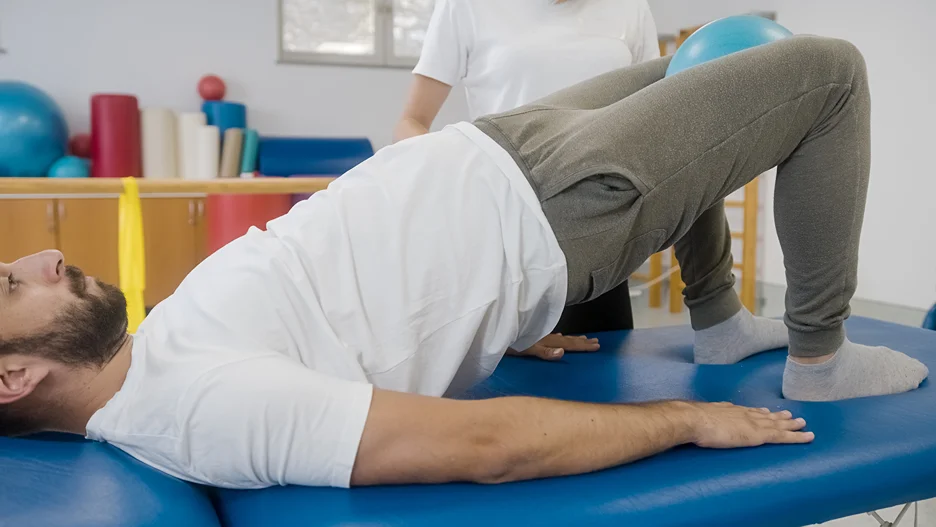Is Your Back Hiding a Dark Secret? DDD & Sciatica Unmasked
Back pain affects millions of people and can significantly impact quality of life. Two common causes of chronic back pain are degenerative disc disease and sciatica.
Read on to learn more about these conditions, their relationship to each other, symptoms, and treatment options.
What is Degenerative Disc Disease?
Degenerative disc disease (DDD) is a gradual wearing down of the discs that cushion vertebrae in your spine. It is a natural consequence of aging, but may be accelerated by factors like obesity, smoking, or a sedentary lifestyle.
As discs break down, the vertebrae move closer together causing back stiffness and pain. Severely degenerated discs may bulge or herniation, putting pressure on spinal nerves.
What Causes Degenerative Disc Disease?
Several factors can contribute to degenerative disc disease:
- Aging – Discs lose fluid content and flexibility with age. By age 60, most people have some disc degeneration.
- Genetics – Some people inherit a predisposition for disc degeneration.
- Injuries – Accidents, falls, or improper lifting can injure discs.
- Lifestyle factors – Being overweight, smoking, or jobs requiring heavy lifting increase stress on discs.
DDD is often the result of multiple factors over time rather than one specific cause. Maintaining a healthy weight and lifestyle can help minimize disc stress.
What are the Symptoms of Degenerative Disc Disease?
Symptoms of DDD may include:
- Chronic lower back pain that may radiate into the buttocks or thighs.
- Stiffness and reduced range of motion in the back.
- Pain that worsens with sitting, bending, lifting, or twisting.
- Numbness or weakness in legs or feet if a compressed nerve is involved.
The location and severity of pain depends on which discs are affected. Many people have disc degeneration without noticeable symptoms. But for some, DDD can cause debilitating pain and disability.
How is Degenerative Disc Disease Diagnosed?
Doctors diagnose DDD based on a medical history, physical exam, and imaging tests. X-rays can reveal narrowed disc space and bony spurs indicative of DDD. MRI scans clearly show degenerated or herniated discs pressing on nerves. CT scans may further characterize bony changes around affected discs. Doctors may also perform tests to assess nerve function and pain levels.
What Treatments are Available for Degenerative Disc Disease?

There are both conservative and surgical options to manage DDD:
- Medications like NSAIDs, muscle relaxants, or analgesic medications can relieve pain and inflammation.
- Physical therapy can improve core and back muscle strength, flexibility, and posture.
- Weight loss helps take pressure off affected discs.
- Smoking cessation reduces disc stress.
- Spinal injections like epidural steroid injections can reduce inflammation.
- Surgery such as spinal fusion or artificial disc replacement may be considered for severe DDD if more conservative treatments fail.
While DDD cannot be reversed, symptoms can often be managed without surgery through a combination of exercise, lifestyle changes, pain management, and physical therapy.
What is Sciatica?
Sciatica refers to radiating leg pain caused by irritation of the sciatic nerve. The sciatic nerve is the largest single nerve in the body, beginning in the lower back and branching down the hips, buttocks, and legs. Sciatica occurs when something presses on the nerve roots, most often a herniated disc in the lower back.
What Causes Sciatica?
Common causes of sciatica include:
- Lumbar herniated discs putting pressure on the sciatic nerve roots. This is the most frequent cause.
- Degenerative disc disease leading to disc bulging or herniation.
- Spinal stenosis – narrowing of the spinal canal that compresses nerves.
- Piriformis syndrome – spasms or tightness of the piriformis muscle compressing the sciatic nerve.
- Injury to the back, pelvis or leg that irritates the sciatic nerve.
Anything that puts pressure on the lower spinal nerves can trigger sciatica, from aging spine changes to acute disc herniations.
What are the Symptoms of Sciatica?
Hallmark sciatica symptoms include:
- Pain in the lower back, buttocks, and leg – usually on one side.
- Tingling, numbness, or muscle weakness along the path of the sciatic nerve.
- Burning or shooting leg pain that may be worse when sitting, coughing, or sneezing.
- Sharp, lightning-like pains or cramps radiating down the leg.
The pain typically follows the route of the sciatic nerve down the back of the thigh and calf on one side. It may feel like a bad leg cramp that doesn’t go away. Moving or stretching the leg can provide temporary relief.
How is Sciatica Diagnosed?
Doctors evaluate sciatica based on a medical history and physical exam. The straight leg raise test can help determine if disc herniation is irritating the sciatic nerve.
Imaging tests like X-ray, CT, or MRI scans may be used to visualize the underlying spinal cause, although they are not always necessary for diagnosis if symptoms clearly indicate sciatica.
How Does Degenerative Disc Disease Related to Sciatica?
Sciatica and degenerative disc disease are closely linked because DDD is a major risk factor for herniated discs.
As discs degenerate, they are more prone to bulging, protrusion, or leaking of disc material. This can press directly onto the spinal nerve roots that merge to form the sciatic nerve, triggering sciatica.
Advanced disc degeneration from DDD combined with activities like bending, lifting, or twisting can cause discs to herniate and compress the sciatic nerve, resulting in acute sciatica pain. DDD and sciatica often co-exist, with sciatica being a common symptom of spinal nerve impingement from age-related disc degeneration.
What Treatments Help Relieve Sciatica?
| Treatment Options for Sciatica | Description |
| 1. Rest, ice/heat, over-the-counter pain medication, and time | Basic self-care measures that may help in mild cases of sciatica. |
| 2. Prescription medications like steroids or muscle relaxants. Anti-inflammatories and pain medications can relieve irritating nerve pressure. | Medications prescribed by a doctor to alleviate nerve pressure and reduce inflammation. |
| 3. Epidural steroid injections into the spine to reduce nerve inflammation. | Injections into the spinal area to reduce inflammation and relieve nerve pressure. |
| 4. Physical therapy exercises to strengthen core and leg muscles, improving spine stability and posture. | Exercises aimed at enhancing core and leg strength, posture, and spine stability. |
| 5. Chiropractic spinal adjustments can relieve pressure on compressed nerves. | Manual adjustments by a chiropractor to alleviate pressure on nerves. |
| 6. Surgery if conservative treatments fail and the disc herniation and nerve impingement are severe. Discectomy or microdiscectomy can remove the portion of a disc pressing on a nerve. | Surgical procedures to remove the portion of a herniated disc causing nerve compression in severe cases. |
Which Exercises Help Relieve Sciatica and Degenerative Disc Disease?

Low-impact exercises that reduce pressure on the lower back can alleviate pain from sciatica and DDD:
- Stretches such as knee-to-chest and pelvic tilts gently stretch lower back muscles.
- Aerobic exercises like walking, swimming, or water aerobics avoid spinal compression.
- Yoga focuses on flexibility, core strength, and proper posture to support the back.
- Pilates strengthens the core muscles that stabilize the spine.
- Avoid exercises that exacerbate pain like running, leg lifts, or sit-ups.
Work with a physical therapist to develop a customized exercise program. Better back muscle strength and flexibility obtained through regular exercise can help reduce spinal nerve irritation.
Can Surgery Provide Long-Term Relief?
For severe sciatica or disc herniations that don’t improve with conservative treatment, surgery may be considered. Options include:
- Discectomy – Removing the portion of a herniated disc impinging on a nerve root.
- Laminectomy – Removing a portion of the bony lamina to increase spinal canal room for compressed nerves.
- Spinal fusion – Fusing two or more vertebrae together for stabilization and to prevent disc herniation.
Surgery can provide significant relief of leg pain and disability related to sciatica. But outcomes are variable, and it is not always a cure. Some people continue to have residual numbness or pain. Post-surgery rehabilitation is vital.
Living with chronic back pain and sciatica can be challenging. Seeking treatment from pain management specialists, chiropractors, and physical therapists skilled in addressing spinal conditions can help develop an integrated treatment approach.
There are many options for relieving discomfort and improving function. Surgery may provide relief when other methods fail. With some patience and perseverance, most people find an effective strategy for managing degenerative disc disease and sciatica.
Connect with the Experts Through Kaly

Managing chronic back pain and sciatic nerve issues can be frustrating. Kaly connects you to top-rated doctors, physical therapists, chiropractors, and other back pain specialists in your area that are experts in treating degenerative disc disease and sciatica.
On Kaly, you can:
- Get matched with a spine specialist based on your unique needs, insurance, and location.
- Book appointments online at a time convenient for you.
- Video chat with doctors to assess your condition and create a treatment plan.
- Message your care team with any questions in between visits.
Take control of your back pain. Visit Kaly.com today to get connected with pain management providers experienced in helping patients with degenerative disc disease and sciatica. Our personalized approach makes it easier to find the right specialist for your needs.
